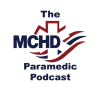On this episode of the MCHD Paramedic Podcast, a special guest, pediatric sedation and pain management expert, Dr. Corrie Chumpitazi, joins the show.
Nitrous oxide has been in our protocols here at MCHD for some time, but probably doesn’t get the recognition and appreciation that it deserves. We’ll discuss nitrous oxide history, dosing, indications, contraindications and side-effects.
Listen to learn why we all should be incorporating more nitrous oxide into our daily EMS practice.
Read more
Understanding pain management
An overview of pain and sedation for the prehospital provider
References
- Ducassé JL et al (2013). Nitrous oxide for early analgesia in the emergency setting: a randomized, double-blind multicenter prehospital trial. Acad Emerg Med. 2013 Feb;20(2):178-84.
- Annequin D and Carbajal R, et al; Fixed 50% Nitrous Oxide Oxygen Mixture for Painful Procedures: A French Survey. Pediatrics. 2000; 105; e47.
- Collado V, Emmanuel N, et al; Expert Opinion: a Review of the Safety of 50% Nitrous Oxide/Oxygen in Conscious Sedation. Drug Safety. 2007, 6(5): 559-571.
- Sanders R, Weimann J, Maze M; Biologic Effects of Nitrous Oxide. Anesthesiology. 2008, 109: 707-722
- Gall O, Annequin D, et al; Adverse Events of Premixed Nitrous Oxide and Oxygen for Procedural Sedation in Children. Lancet. 2001; 358: 1514-15.
- Tobias, JD, Review Article: Applications of Nitrous Oxide for Procedural Sedation in the Pediatric Population. Pediatric Emergency Care. 2013; 29: 245-265.
- Onody P, Gil P, Hennequin M. Safety of Inhalation of a 50% Nitrous Oxide/Oxygen Premix: A Prospective Study of 35,828 Administrations. Drug Safety. 2006; 29(7):633-640.
- American Academy of Pediatric Dentistry. (2013). Guideline on use of nitrous oxide for pediatric dental patients. Retrieved September 3, 2013, from www.aapd.org: http://www.aapd.org/media/Policies_Guidelines/G_Nitrous.pdf
- Heinrich M, Menzel C, Hoffmann F, et al. Self-administered procedural analgesia using nitrous oxide/oxygen (50:50) in the pediatric surgery emergency room: effectiveness and limitations. Eur J Pediatr Surg. 2015;25(3):250-6.
- Pasaron R, Burnweit C, Zerpa J, et al. Nitrous oxide procedural sedation in non-fasting pediatric patients undergoing minor surgery: a 12-year experience with 1,058 patients. Pediatr Surg Int. 2015;31(2):173-80.
- Zier JL, Liu M. Safety of high-concentration nitrous oxide by nasal mask for pediatric procedural sedation: experience with 7802 cases. Pediatr Emerg Care. 2011;27(12):1107-12.
- Gamis AS, Knapp JF, Glenski JA. Nitrous oxide analgesia in a pediatric emergency department. Ann Emerg Med. 1989;18(2):177-81.
- Martin HA, Noble M, Wodo N. The Benefits of Introducing the Use of Nitrous Oxide in the Pediatric Emergency Department for Painful Procedures. J Emerg Nurs. 2018;44(4):331-5.














